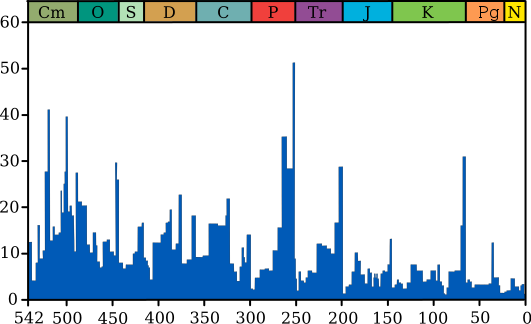https://en.wikipedia.org/wiki/Triassic%E2%80%93Jurassic_extinction_event wrote:
<<The Triassic–Jurassic extinction event marks the boundary between the Triassic and Jurassic periods, 201.3 million years ago, and is one of the major extinction events of the Phanerozoic eon. This event vacated terrestrial ecological niches, allowing the dinosaurs to assume the dominant roles in the Jurassic period. This event happened in less than 10,000 years and occurred just before Pangaea started to break apart.
Some have theorized that an impact from an asteroid or comet may have caused the Triassic-Jurassic extinction, similar to the extraterrestrial object which was the main factor in the Cretaceous-Paleogene extinction about 66 million years ago, as evidenced by the Chicxulub crater in Mexico. However, so far no impact crater of sufficient size has been dated to precisely coincide with the Triassic–Jurassic boundary.
Nevertheless, the late Triassic did experience several impacts, including the second-largest confirmed impact in the Mesozoic. The Manicouagan Reservoir in Quebec is one of the most visible large impact craters on Earth, and at 100 km in diameter it is tied with the Eocene Popigai crater in Siberia as the fourth-largest impact crater on Earth. Olsen et al. (1987) were the first scientists to link the Manicouagan crater to the Triassic-Jurassic extinction, citing its age which at the time was roughly considered to be late Triassic. More precise radiometric dating by Hodych & Dunning (1992) has shown that the Manicouagan impact occurred about 214 million years ago, about 13 million years before the Triassic-Jurassic boundary. Nevertheless, the Manicougan impact did have a widespread effect on the planet; a 214-million-year-old ejecta blanket of shocked quartz has been found in rock layers as far away as England and Japan. There is still a possibility that the Manicouagan impact was responsible for a small extinction midway through the late Triassic at the Carnian-Norian boundary, although the disputed age of this boundary (and whether an extinction actually occurred in the first place) makes it difficult to correlate the impact with extinction.
Onoue et al. (2016) alternatively proposed that the Manicouagan impact was responsible for a marine extinction in the middle of the Norian which impacted radiolarians, sponges, conodonts, and Triassic ammonoids. Thus, the Manicouagan impact may have been partially responsible for the gradual decline in the latter two groups which culminated in their extinction at the Triassic-Jurassic boundary.
Other Triassic craters are closer to the Triassic-Jurassic boundary but also much smaller than the Manicouagan reservoir. The eroded Rochechouart crater in France has most recently been dated to 201 ±2 million years ago, but at 25 km across, it appears to be too small to have affected the ecosystem. Other putative or confirmed Triassic craters include the 80 km wide Puchezh-Katunki crater in Eastern Russia, the 40 km wide Saint Martin crater in Manitoba, the 15 km wide Obolon' crater in Ukraine, and the 9 km wide Red Wing Creek structure in North Dakota. Spray et al. (1998) noted an interesting phenomenon, that being how the Manicoagan, Rochechoart, and Saint Martin craters all seem to be at the same latitude, and that the Obolon' and Red Wing craters form parallel arcs with the Rochechoart and Saint Martin craters, respectively. Spray and his colleagues hypothesized that the Triassic experienced a "multiple impact event", a large fragmented asteroid or comet which broke up and impacted the earth in several places at the same time. Such an impact has been observed in the present day, when Comet Shoemaker-Levy 9 broke up and hit Jupiter in 1992. However, the "multiple impact event" hypothesis for Triassic impact craters has not been well-supported; Kent (1998) noted that the Manicouagan and Rochechoart craters were formed in eras of different magnetic polarity, and radiometric dating of the individual craters has shown that the impacts occurred millions of years apart.>>
 Manicouagan Impact Crater from Space
Manicouagan Impact Crater from Space